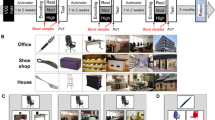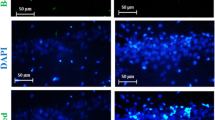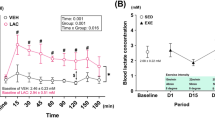Abstract
We demonstrate that exercise enables hippocampal-dependent learning in conditions that are normally subthreshold for encoding and memory formation, and depends on hippocampal induction of brain-derived neurotrophic factor (BDNF) as a key mechanism. Using a weak training paradigm in an object location memory (OLM) task, we show that sedentary mice are unable to discriminate 24 h later between familiar and novel object locations. In contrast, 3 weeks of prior voluntary exercise enables strong discrimination in the spatial memory task. Cognitive benefits of exercise match those attained with post-training sodium butyrate (NaB), a histone deacetylase (HDAC) inhibitor previously shown to enable subthreshold learning. We demonstrate that the enabling effects of exercise and NaB on subthreshold OLM learning are dependent on hippocampal BDNF upregulation, and are blocked by hippocampal infusion of BDNF short-interfering RNA. Exercise and NaB increased bdnf transcripts I and IV, and the increases were associated with BDNF promoter acetylation on H4K8 but not H4K12. These data provide support for the concept that exercise engages epigenetic control mechanisms and serves as a natural stimulus that operates in part like NaB and potentially other HDAC inhibitors, placing the brain into a state of readiness for plasticity.
Similar content being viewed by others
Log in or create a free account to read this content
Gain free access to this article, as well as selected content from this journal and more on nature.com
or
References
Abel JL, Rissman EF (2012). Running-induced epigenetic and gene expression changes in the adolescent brain. Int J Dev Neurosci e-pub ahead of print. doi:pii:S0736-5748(12)00585-0.
Ahlskog JE, Geda YE, Graff-Radford NR, Petersen RC (2011). Physical exercise as a preventive or disease-modifying treatment of dementia and brain aging. Mayo Clin Proc 86: 876–884.
Alarcon JM, Malleret G, Touzani K, Vronskaya S, Ishii S, Kandel ER et al (2004). Chromatin acetylation, memory, and LTP are impaired in CBP+/− mice: a model for the cognitive deficit in Rubinstein-Taybi syndrome and its amelioration. Neuron 42: 947–959.
Barrett RM, Malvaez M, Kramar E, Matheos DP, Arrizon A, Cabrera SM et al (2011). Hippocampal focal knockout of CBP affects specific histone modifications, long-term potentiation, and long-term memory. Neuropsychopharmacology 36: 1545–1556.
Bekinschtein P, Oomen CA, Saksida LM, Bussey TJ (2011). Effects of environmental enrichment and voluntary exercise on neurogenesis, learning and memory, and pattern separation: BDNF as a critical variable? Semin Cell Dev Biol 22: 536–542.
Berchtold NC, Castello N, Cotman CW (2010). Exercise and time-dependent benefits to learning and memory. Neuroscience 167: 588–597.
Bredy TW, Wu H, Crego C, Zellhoefer J, Sun YE, Barad M (2007). Histone modifications around individual BDNF gene promoters in prefrontal cortex are associated with extinction of conditioned fear. Learn Mem 14: 268–276.
Calfa G, Chapleau CA, Campbell S, Inoue T, Morse SJ, Lubin FD et al (2012). HDAC activity is required for BDNF to increase quantal neurotransmitter release and dendritic spine density in CA1 pyramidal neurons. Hippocampus 22: 1493–1500.
Cassilhas RC, Lee KS, Fernandes J, Oliveira MG, Tufik S, Meeusen R et al (2012). Spatial memory is improved by aerobic and resistance exercise through divergent molecular mechanisms. Neuroscience 202: 309–317.
Chwang WB, O'Riordan KJ, Levenson JM, Sweatt JD (2006). ERK/MAPK regulates hippocampal histone phosphorylation following contextual fear conditioning. Learn Mem 13: 322–328.
Cotman CW, Berchtold NC (2002). Exercise: a behavioral intervention to enhance brain health and plasticity. Trends Neurosci 25: 292–298.
Cotman CW, Berchtold NC (2007). Physical activity and the maintenance of cognition: learning from animal models. Alzheimers Dement 3: S30–S37.
Cotman CW, Berchtold NC, Christie LA (2007). Exercise builds brain health: an interplay of central and peripheral factors. Trends Neurosci 30: 467–471.
Farmer J, Zhao X, van Praag H, Wodtke K, Gage FH, Christie BR (2004). Effects of voluntary exercise on synaptic plasticity and gene expression in the dentate gyrus of adult male Sprague-Dawley rats in vivo. Neuroscience 124: 71–79.
Gomez-Pinilla F, Zhuang Y, Feng J, Ying Z, Fan G (2011). Exercise impacts brain-derived neurotrophic factor plasticity by engaging mechanisms of epigenetic regulation. Eur J Neurosci 33: 383–390.
Gorski JA, Balogh SA, Wehner JM, Jones KR (2003). Learning deficits in forebrain-restricted brain-derived neurotrophic factor mutant mice. Neuroscience 121: 341–354.
Gottmann K, Mittmann T, Lessmann V (2009). BDNF signaling in the formation, maturation and plasticity of glutamatergic and GABAergic synapses. Exp Brain Res 199: 203–234.
Korzus E, Rosenfeld MG, Mayford M (2004). CBP histone acetyltransferase activity is a critical component of memory consolidation. Neuron 42: 961–972.
Kouzarides T (2007). Chromatin modifications and their function. Cell 128: 693–705.
Levenson JM, O'Riordan KJ, Brown KD, Trinh MA, Molfese DL, Sweatt JD (2004). Regulation of histone acetylation during memory formation in the hippocampus. J Biol Chem 279: 40545–40559.
Lu Y, Christian K, Lu B (2008). BDNF: a key regulator for protein synthesis-dependent LTP and long-term memory? Neurobiol Learn Mem 89: 312–323.
Ma YL, Wang HL, Wu HC, Wei CL, Lee EH (1998). Brain-derived neurotrophic factor antisense oligonucleotide impairs memory retention and inhibits long-term potentiation in rats. Neuroscience 82: 957–967.
McQuown SC, Barrett RM, Matheos DP, Post RJ, Rogge GA, Alenghat T et al (2011). HDAC3 is a critical negative regulator of long-term memory formation. J Neurosci 31: 764–774.
Middleton LE, Barnes DE, Lui LY, Yaffe K (2010). Physical activity over the life course and its association with cognitive performance and impairment in old age. J Am Geriatr Soc 58: 1322–1326.
Mizuno M, Yamada K, Olariu A, Nawa H, Nabeshima T (2000). Involvement of brain-derived neurotrophic factor in spatial memory formation and maintenance in a radial arm maze test in rats. J Neurosci 201: 7116–7121.
Mu JS, Li WP, Yao ZB, Zhou XF (1999). Deprivation of endogenous brain-derived neurotrophic factor results in impairment of spatial learning and memory in adult rats. Brain research 835: 259–265.
Neeper SA, Gomez PF, Choi J, Cotman CW (1996). Physical activity increases mRNA for brain-derived neurotrophic factor and nerve growth factor in rat brain. Brain Res 726: 49–56.
Oliff HS, Berchtold NC, Isackson P, Cotman CW (1998). Exercise-induced regulation of brain-derived neurotrophic factor (BDNF) transcripts in the rat hippocampus. Brain Res Mol Brain Res 61: 147–153.
Ou LC, Gean PW (2007). Transcriptional regulation of brain-derived neurotrophic factor in the amygdala during consolidation of fear memory. Mol Pharmacol 72: 350–358.
Peleg S, Sananbenesi F, Zovoilis A, Burkhardt S, Bahari-Javan S, Agis-Balboa RC et al (2010). Altered histone acetylation is associated with age-dependent memory impairment in mice. Science 328: 753–756.
Rex CS, Lin CY, Kramar EA, Chen LY, Gall CM, Lynch G (2007). Brain-derived neurotrophic factor promotes long-term potentiation-related cytoskeletal changes in adult hippocampus. J Neurosci 27: 3017–3029.
Rouaux C, Jokic N, Mbebi C, Boutillier S, Loeffler JP, Boutillier AL (2003). Critical loss of CBP/p300 histone acetylase activity by caspase-6 during neurodegeneration. EMBO J 22: 6537–6549.
Russo-Neustadt AA, Beard RC, Huang YM, Cotman CW (2000). Physical activity and antidepressant treatment potentiate the expression of specific brain-derived neurotrophic factor transcripts in the rat hippocampus. Neuroscience 101: 305–312.
Sahar S, Reddy MA, Wong C, Meng L, Wang M, Natarajan R (2007). Cooperation of SRC-1 and p300 with NF-kappaB and CREB in angiotensin II-induced IL-6 expression in vascular smooth muscle cells. Arterioscler Thromb Vasc Biol 27: 1528–1534.
Shen H, Tong L, Balazs R, Cotman CW (2001). Physical activity elicits sustained activation of the cyclic AMP response element-binding protein and mitogen-activated protein kinase in the rat hippocampus. Neuroscience 107: 219–229.
Stafford JM, Raybuck JD, Ryabinin AE, Lattal KM (2012). Increasing histone acetylation in the hippocampus-infralimbic network enhances fear extinction. Biol Psychiatry 72: 25–33.
Stefanko DP, Barrett RM, Ly AR, Reolon GK, Wood MA (2009). Modulation of long-term memory for object recognition via HDAC inhibition. Proc Natl Acad Sci USA 106: 9447–9452.
Urdinguio RG, Sanchez-Mut JV, Esteller M (2009). Epigenetic mechanisms in neurological diseases: genes, syndromes, and therapies. Lancet Neurol 8: 1056–1072.
van Praag H, Christie BR, Sejnowski TJ, Gage FH (1999). Running enhances neurogenesis, learning, and long-term potentiation in mice. Proc Natl Acad Sci USA 96: 13427–13431.
Vaynman S, Ying Z, Gomez-Pinilla F (2004). Hippocampal BDNF mediates the efficacy of exercise on synaptic plasticity and cognition. Eur J Neurosci 20: 2580–2590.
Vecsey CG, Hawk JD, Lattal KM, Stein JM, Fabian SA, Attner MA et al (2007). Histone deacetylase inhibitors enhance memory and synaptic plasticity via CREB:CBP-dependent transcriptional activation. J Neurosci 27: 6128–6140.
Voss MW, Nagamatsu LS, Liu-Ambrose T, Kramer AF (2011). Exercise, brain, and cognition across the lifespan. J Appl Physiol 111: 1505–1513.
Wang D, Xia X, Weiss RE, Refetoff S, Yen PM (2010). Distinct and histone-specific modifications mediate positive versus negative transcriptional regulation of TSHalpha promoter. PLoS ONE 5: e9853.
Wood MA, Kaplan MP, Park A, Blanchard EJ, Oliveira AM, Lombardi TL et al (2005). Transgenic mice expressing a truncated form of CREB-binding protein (CBP) exhibit deficits in hippocampal synaptic plasticity and memory storage. Learn Mem 12: 111–119.
Zeng Y, Tan M, Kohyama J, Sneddon M, Watson JB, Sun YE et al (2011). Epigenetic enhancement of BDNF signaling rescues synaptic plasticity in aging. J Neurosci 31: 17800–17810.
Acknowledgements
Funding was provided by the following: NIA Grants AG00538 and AG34667 (CWC), T32AG9629 (KAI), NIMH Grant MH081004 (MAW), and NRSA predoctoral fellowship F31DA29368 (MM). We thank Arpine Kirakos for technical assistance with ChIP assays and Dina Matheos for helpful RT-qPCR advice.
Author information
Authors and Affiliations
Corresponding author
Ethics declarations
Competing interests
The authors declare no conflict of interest.
Additional information
Supplementary Information accompanies the paper on the Neuropsychopharmacology website
Rights and permissions
About this article
Cite this article
Intlekofer, K., Berchtold, N., Malvaez, M. et al. Exercise and Sodium Butyrate Transform a Subthreshold Learning Event into Long-Term Memory via a Brain-Derived Neurotrophic factor-Dependent Mechanism. Neuropsychopharmacol 38, 2027–2034 (2013). https://doi.org/10.1038/npp.2013.104
Received:
Revised:
Accepted:
Published:
Issue date:
DOI: https://doi.org/10.1038/npp.2013.104
Keywords
This article is cited by
-
Effect of a multi-strain probiotic mixture consumption on anxiety and depression symptoms induced in adult mice by postnatal maternal separation
Microbiome (2024)
-
Effect of gut microbiota-derived metabolites and extracellular vesicles on neurodegenerative disease in a gut-brain axis chip
Nano Convergence (2024)
-
Specific exercise patterns generate an epigenetic molecular memory window that drives long-term memory formation and identifies ACVR1C as a bidirectional regulator of memory in mice
Nature Communications (2024)
-
Early-life exercise primes the murine neural epigenome to facilitate gene expression and hippocampal memory consolidation
Communications Biology (2023)
-
Relationship Between Short-chain Fatty Acids and Parkinson’s Disease: A Review from Pathology to Clinic
Neuroscience Bulletin (2023)



